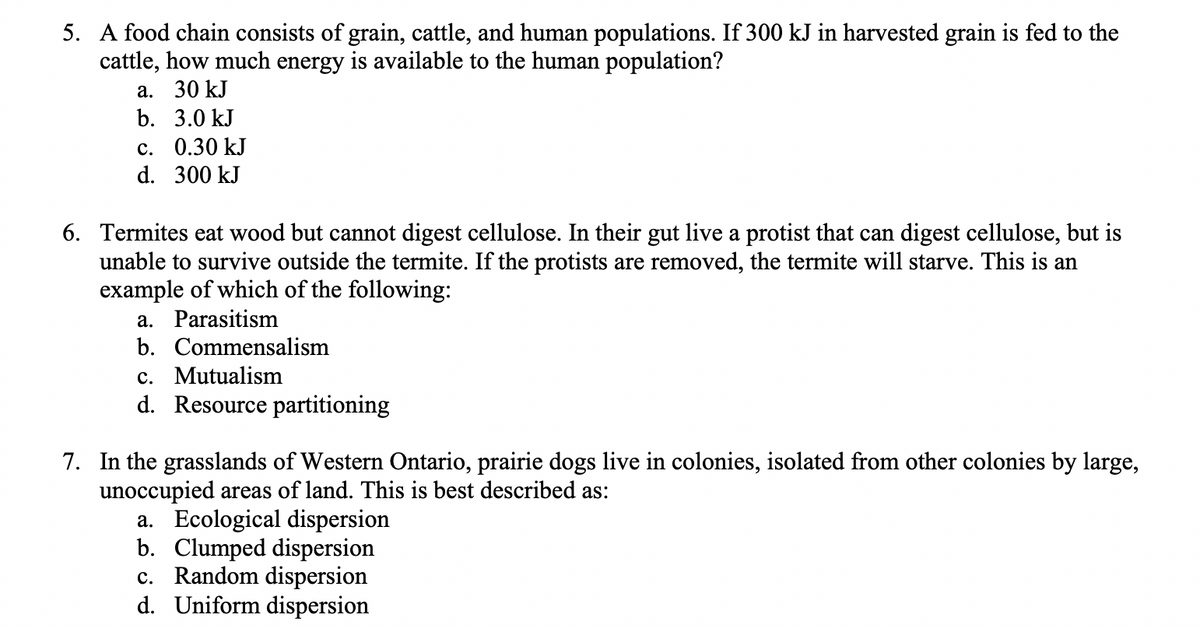Cattie, noW Imuch energy is aval Ule to the numani popul а. 30 kJ b. 3.0 kJ с. 0.30 kJ d. 300 kJ Termites eat wood but cannot digest cellulose. In their gut live a protist that can digest cellulose, but is unable to survive outside the termite. If the protists are removed, the termite will starve. This is an example of which of the following: a. Parasitism b. Commensalism c. Mutualism d. Resource partitioning In the grasslands of Western Ontario, prairie dogs live in colonies, isolated from other colonies by large, unoccupied areas of land. This is best described as: a. Ecological dispersion b. Clumped dispersion c. Random dispersion d. Uniform dispersion
Cattie, noW Imuch energy is aval Ule to the numani popul а. 30 kJ b. 3.0 kJ с. 0.30 kJ d. 300 kJ Termites eat wood but cannot digest cellulose. In their gut live a protist that can digest cellulose, but is unable to survive outside the termite. If the protists are removed, the termite will starve. This is an example of which of the following: a. Parasitism b. Commensalism c. Mutualism d. Resource partitioning In the grasslands of Western Ontario, prairie dogs live in colonies, isolated from other colonies by large, unoccupied areas of land. This is best described as: a. Ecological dispersion b. Clumped dispersion c. Random dispersion d. Uniform dispersion
Biology: The Dynamic Science (MindTap Course List)
4th Edition
ISBN:9781305389892
Author:Peter J. Russell, Paul E. Hertz, Beverly McMillan
Publisher:Peter J. Russell, Paul E. Hertz, Beverly McMillan
Chapter54: Ecosystems And Global Change
Section: Chapter Questions
Problem 1TYK
Related questions
Question
please please answer all three pls

Transcribed Image Text:5. A food chain consists of grain, cattle, and human populations. If 300 kJ in harvested grain is fed to the
cattle, how much energy is available to the human population?
a. 30 kJ
b. 3.0 kJ
c. 0.30 kJ
d. 300 kJ
6. Termites eat wood but cannot digest cellulose. In their gut live a protist that can digest cellulose, but is
unable to survive outside the termite. If the protists are removed, the termite will starve. This is an
example of which of the following:
a. Parasitism
b. Commensalism
c. Mutualism
d. Resource partitioning
7. In the grasslands of Western Ontario, prairie dogs live in colonies, isolated from other colonies by large,
unoccupied areas of land. This is best described as:
a. Ecological dispersion
b. Clumped dispersion
c. Random dispersion
d. Uniform dispersion
Expert Solution
This question has been solved!
Explore an expertly crafted, step-by-step solution for a thorough understanding of key concepts.
Step by step
Solved in 2 steps

Knowledge Booster
Learn more about
Need a deep-dive on the concept behind this application? Look no further. Learn more about this topic, biology and related others by exploring similar questions and additional content below.Recommended textbooks for you

Biology: The Dynamic Science (MindTap Course List)
Biology
ISBN:
9781305389892
Author:
Peter J. Russell, Paul E. Hertz, Beverly McMillan
Publisher:
Cengage Learning

Biology 2e
Biology
ISBN:
9781947172517
Author:
Matthew Douglas, Jung Choi, Mary Ann Clark
Publisher:
OpenStax

Biology: The Unity and Diversity of Life (MindTap…
Biology
ISBN:
9781337408332
Author:
Cecie Starr, Ralph Taggart, Christine Evers, Lisa Starr
Publisher:
Cengage Learning

Biology: The Dynamic Science (MindTap Course List)
Biology
ISBN:
9781305389892
Author:
Peter J. Russell, Paul E. Hertz, Beverly McMillan
Publisher:
Cengage Learning

Biology 2e
Biology
ISBN:
9781947172517
Author:
Matthew Douglas, Jung Choi, Mary Ann Clark
Publisher:
OpenStax

Biology: The Unity and Diversity of Life (MindTap…
Biology
ISBN:
9781337408332
Author:
Cecie Starr, Ralph Taggart, Christine Evers, Lisa Starr
Publisher:
Cengage Learning

Biology: The Unity and Diversity of Life (MindTap…
Biology
ISBN:
9781305073951
Author:
Cecie Starr, Ralph Taggart, Christine Evers, Lisa Starr
Publisher:
Cengage Learning

Biology (MindTap Course List)
Biology
ISBN:
9781337392938
Author:
Eldra Solomon, Charles Martin, Diana W. Martin, Linda R. Berg
Publisher:
Cengage Learning